
By Steve Benner for CoinWeek …..
Lucania was one of the most important regions of Magna Graecia, an area that encompassed the Greek colonies of Sicily and Italy. Lucania was located in southern Italy, straddling the peninsula between the Gulf of Taranto and the Tyrrhenian Sea. It was bordered on the northwest by Campania, the north by Samnium, the northeast by Apulia, and the south by Bruttium. Most of Lucania’s area is covered by the Apennine Mountains, with land gently sloping to the sea on both coasts. Greek colonists started arriving in the eighth century BCE, displacing the Lucani people, an Osco-Samnite population from central Italy. All the major ancient Greek cities were located along the coast (the red dots on the map above) and usually near rivers, such as the Bradanus, the Casuentus, the Aciris, the Siris, the Sybaris, and the Silarus.
Metapontum (Metapontion)
Starting in the northeast corner of the area and moving clockwise, Metapontum was founded by Achaians late in the eighth century and is located between the rivers Bradanus and Casuentus. The founder of the city is thought to be a leader called Leucippus, who managed to strike a deal with the citizens of the nearby city of Taranto. The land was very fertile, and, when the city began minting coins around 550 BCE, an ear of wheat was depicted on the coins. Lucania became very prosperous, possessing its own treasury at Delphi. Pythagoras spent the last part of the fifth century in Metapontum, where he died and was buried. Metapontum supported Athens in its disastrous attack on Syracuse (415-413) and supported Alexander of Epirus (332), who was invited into Italy to help the Greeks fight the Italic tribes. When Alexander was killed, he also was buried near Metapontum. The city was captured by Cleonymus of Sparta in 303/2, and, during the Second Punic War (218-201), Hannibal used the city as his headquarters. After the war, the city never regained its former glory, and, in 279, it surrendered to Rome, which was fighting Pyrrhus of Epirus at the time. By the second century CE, only the theater and some walls were left standing.
In the middle of the sixth century BCE, Metapontum began minting silver coins to the Achaian standard of 7.9 grams to the nomos. These first coins were nomoi and fractions. They were struck on broad, thin flans with a grain ear as a raised design on the obverse and a grain ear on the reverse but with an incuse design (Figure 2). This raised/incuse design was struck by other Lucanian cities such as Taranto, Sybaris, Laos, and Poseidonia. This technique lasted for about a century. Later the wheat ear obverse was paired with the standing figure of Apollo, Herakles, or Acheloos.
Around 430, the grain ear was moved to the reverse and the obverse had a profile usually of Demeter (Figure 3), but also Apollo, Herakles, Nike, Zeus, Leukippos, Homonia, Hygieia, and Tharragoras (“Brave”). An issue of a double nomoi with the head of Leukippos obverse and grain reverse was minted from 340 to 330.
The Metapontum silver fractions included the drachm (2.63 g.), triobols, (1.3 g.), 2.5 obols (1 g.), diobols (0.86 g), trihemiobols (0.65 g.), and obols (0.43 g.). The types were very similar to those of the nomos. If the city name was on the coin, it could be any number of letters from ME to ΜΕΤΑΠΟΝΤΙΝΩΝ.
Around 280, the silver coinage switched to the Tarentine standard of 3.2 grams to the drachm, and, circa 215, the coinage switched again, this time to the Punic standard of 3.75 grams to the didrachm. After the Second Punic War, silver coinage ceased being minted.
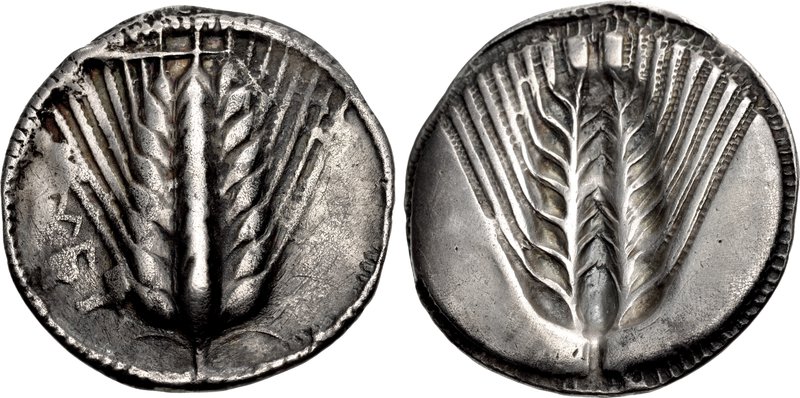
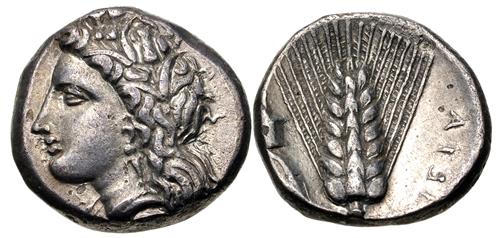
The bronze coinage was started in the late fifth century with two denominations, one of which had the value of a silver obol. By the early third century, there were five denominations of bronze coins, ranging from 6 to 0.68 grams. The types for the bronze coins were similar to those for the silver denominations. Figure 5 shows a bronze coin with Athena wearing a Corinthian helmet obverse and three barley grains arranged in a circle reverse. Bronze city coinage ended late in the second century.
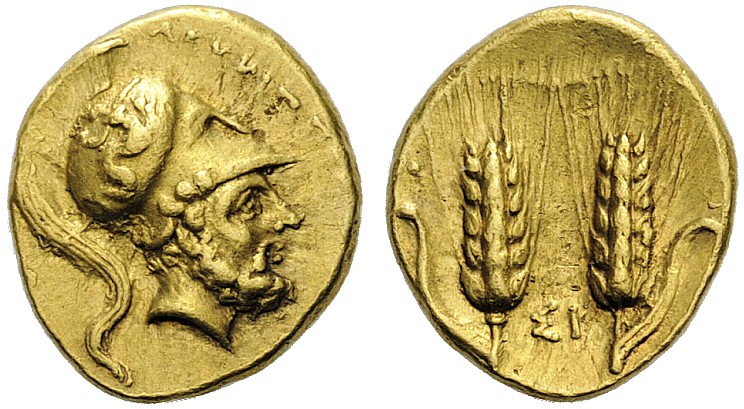
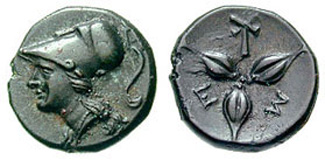
Heraclea (Heracleia)
Heraclea was located south of Metapontum near the River Aciris. It was established later than the other colonies in the area, near the Ionic colony of Siris, which was destroyed by Kroton, Metapontum, and Sybaris in 510 BCE. As Siris’ replacement, Heraclea was jointly founded by Thourioi and Taras (Taranto) around 443/2, with Siris serving as its harbor. Under the protection of Taras, the colony was to serve as a bulwark against the incursions of the native Lucanians. Heraclea quickly grew in prosperity and power. Athena was the main deity worshipped at Heraclea though temples to Demeter and Kore (Persephone) were located near the city. Also, the city became a leading center for the production of vases during the third and fourth centuries.
Early in the fourth century, Heraclea was chosen as the seat of the general assembly of the League of Italian Greeks, but in the 330s, Heraclea fell to the Lucanians, and not until Alexander of Epirus defeated the Lucanians in 332 was its freedom restored. Alexander moved the League’s seat to Thourioi due to his hostility to Taranto.
In 280, the city was the site of a major battle between the Romans and Pyrrhus of Epirus, the first of the Greek general’s pyrrhic victories. In order to win over Heraclea, the Romans granted the city very favorable terms of alliance (278), which the inhabitants retained through the Roman Republic. It was subjugated by Hannibal in 212 and suffered during the Social War (91-87). However, Heraclea recovered and remained an important city during the Roman Empire, eventually becoming deserted sometime after the Empire’s fall.
Heraclea began minting its silver coins to the Achaian standard soon after its foundation. The obverse was usually Athena in reference to its Ionic heritage, and the reverse showed Herakles, which is referencing the Dorian influence of Taras (Figure 6), wrestling the Nemean lion or standing holding a club and bow. The silver staters and fraction had similar types. The fractions were diobols (0.87 g) and pentonkions (0.34 g.). At the time of Pyrrhus’ War in the 280s, the weight declined from the Achaian standard to that of the Tarentine of 6.6 grams (didrachm). The fractions were the drachm (3.7 g.), diobols (0.1.2 g.) and pentonkions (0.41 g). The types mainly had Herakles standing with club and bow though the pentonkions had a barleycorn and plow combination and the drachm an owl reverse instead of Herakles (Figure 7). Also at this time, Heraclea minted quarter gold staters to the Attic standard of 8.6 grams to the stater. The coin had the typical Athena and Herakles obverse and reverse and is extremely rare (Figure 8). The minting of silver coins stopped completely by the end of the third century.
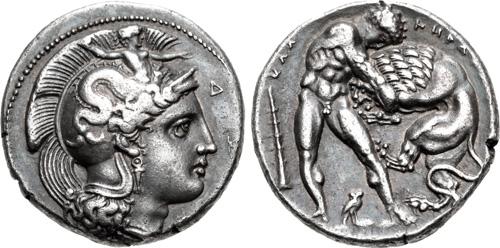
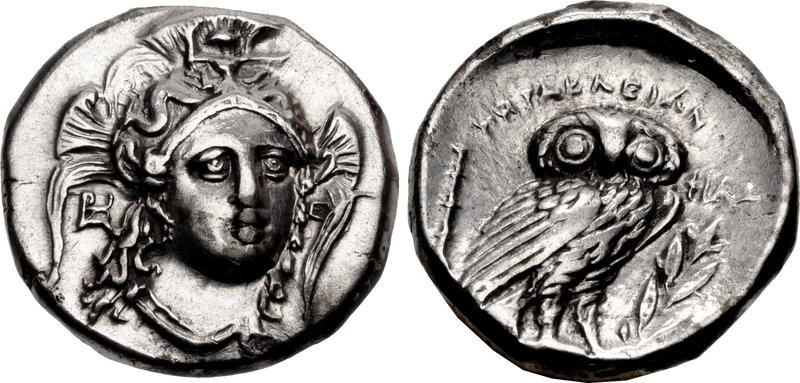
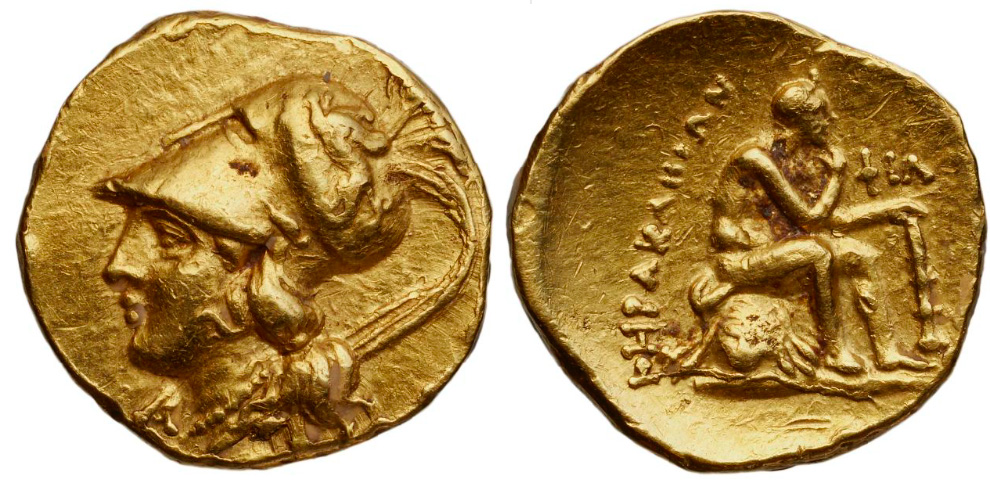
The minting of bronze coinage also began at this time and continued until the middle of the second century. For simplicity, the bronze coins are separated here into groups based on weight since the actual denominations are not known. There were four groups: B) 5-8.5 g.; C) 5-8.5 g.; D) 1.95-3.0 g.; and E) 1.06-1.3 g. Group B is the most diverse of the bronzes having the head of Athena or Demeter, galloping horse, or two figures of Herakles on their obverse, and an owl, crescents and pellets, grain ear, or Athena standing on the reverse. Group C has a head of Herakles or Athena obverse and a club/quiver/bow or Herakles standing reverse. Group D has the head of Athena or Herakles, a horse forepart, or a skyphos obverse and a reverse of a trophy, Glaukos, owl, quiver, club, or standing Herakles (Figure 9). Finally, Group E pairs either an obverse of a thunderbolt or the head of Herakles with a club reverse.
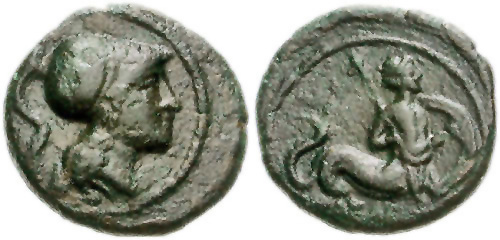
Sybaris
Sybaris was located on the east coast, near the border with Bruttium. Sybaris was the earliest Greek colony founded in southern Italy, established around 720 BCE by Achaian and Troizen colonists. It was situated on a plain between the rivers Sybaris and Crathis. The mythological founder was believed to have been the son of Ajax, a Lokrian hero. Soon after its founding, the majority of Achaians drove the Troizen settlers out, yet by the sixth century, it was welcoming in colonists from other cities. The land was very fertile, and the city prospered while the population grew wealthy. The inhabitants were said to be so fond of luxury that the word “sybaritic” came to mean “addicted to outrageous pleasure-seeking”. It maintained relations with the Etruscans and Ionian Greeks, and established colonies at Laos, Skidros, and Poseidonia.
In 530 to 510 BCE, Sybaris formed an Italiote League with other Achaian cities for the purpose of destroying the colony of Siris. After destroying Siris, the Sybarites suffered internal strife that led to the exile of many wealthy citizens to nearby Kroton in Bruttium. When Kroton refused to return the exiles, a war between the two cities was fought, leading to the defeat and destruction of Sybaris in 510. In 467, the Sybarites in exile tried to reestablish the city, but they were again defeated by Kroton. Another attempt was made in 453, this time with Thessalian colonists, but Kroton drove them out again. This time the Sybarites successfully appealed to Athens and Sparta for help. The Athenian and Peloponnesian settlers freed Sybaris from Kroton, but the Sybarites refused to grant full citizenship to the new settlers, resulting in the death or expulsion of the entire Sybarite population. The city was then refounded as Thourioi. The Sybarite exiles tried to create a new city near the Traeis River, but they were soon destroyed by the Brettians.
The silver coinage of Sybaris has been divided into five groups (the city did not mint gold or bronze coins). The first group is from the mid-sixth century when the autonomous city of Sybaris began to strike staters and fractions to the Achaian standard. The flans were broad and thin with a raised obverse and incuse reverse of a bull. The bull was a tauriform representation of the Sybaris River. This style was used on the staters, drachms (2.63 g.), and tetrobols (1.75 g.) whereas the triobols (1.3 g.) and obols (0.43 g.) paired the bull with a reverse of either a tripod or initials of the city (Figures 10 & 11). The “VM” as the city initials uses an epichoric (local) alphabet that uses san (M) in place of sigma (Σ).
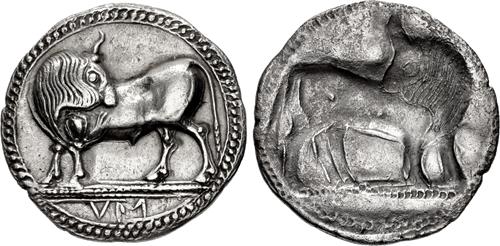

Group II was following the Kroton conquest when the exiles were in Laos. The Sybarites struck staters, triobols, and obols. The same styles were used except that the reverse had an amphora for the triobols and an acorn for the obols (the acorn is the civic badge of Laos). These coins are very rare. Group III coins were minted during the second foundation from 453 to 448 and included the same denominations as Group II. Now the coins feature Poseidon with trident on the obverse and a bull or bird on the reverse (Figure 12), probably due to the influence of the Thessalian settlers.
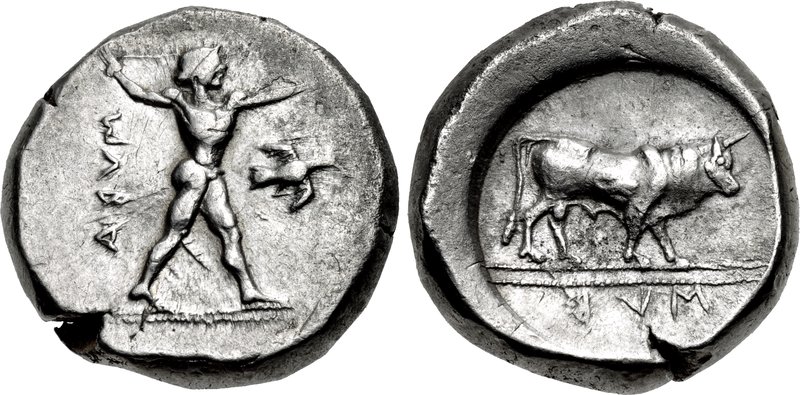
Group IV coinage was made during the third foundation of the city between 446-440 and consisted of drachms, triobols, and trihemiobols (0.63 g.). There is strong Athenian influence in the coinage with the head of Athena obverse and bull reverse, which was used later on the Thourioi coins (Figure 13).
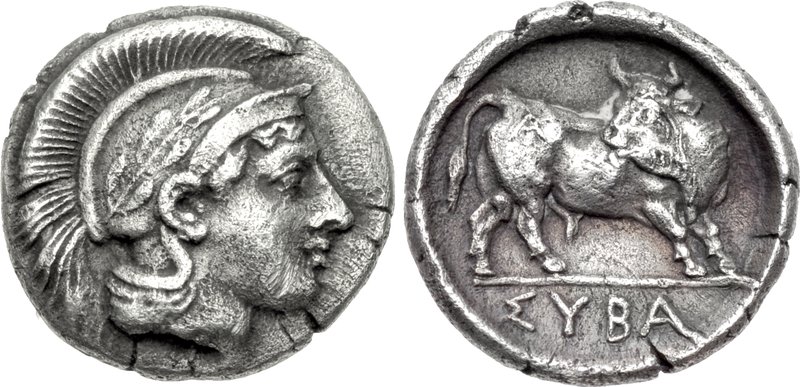
The last group’s (Group V) coinage was minted during the Sybarites resettlement on the Traeis River after their expulsion by the Athenians in 440. The nomos’ (tridrachms) design reverted back to the raised obverse bull and the incuse reverse bull of Group I but with a thicker flan (still 7.9 g; see Figure 10). The triobols used the Poseidon obverse and bull reverse from Group III, see Figure 12. A later issue replaced Poseidon with a charging horseman.
The second part of this article will cover the coinage of Thourioi, which was founded by citizens of Sybaris in 443, and three other major Lucanian cities: Laos, Elea, and Poseidoina.
* * *
About the Author
Steve M. Benner has a Ph.D. in engineering from the Ohio State University and worked for NASA at the Goddard Space Flight Center in Greenbelt, Maryland, for almost three decades before retiring in 2016. He has been an ancient coin collector since the early 1970s and is a member of the ANS, the ANA, and the ACCG. He specializes in coins of the ancient Greek leagues and in Roman Imperial bronzes. Dr. Benner has published over 30 ancient coin articles in various publications and is the author of Achaian League Coinage of the 3rd through 1st Centuries B.C.E. (2008) and History and Coinage of the Ancient Greek Leagues, 5th through 1st Centuries B.C.E. (2018).





Nice, informative article about some of the most beautiful coins ever minted.
However Taras (Taranto) was not in Lucania.